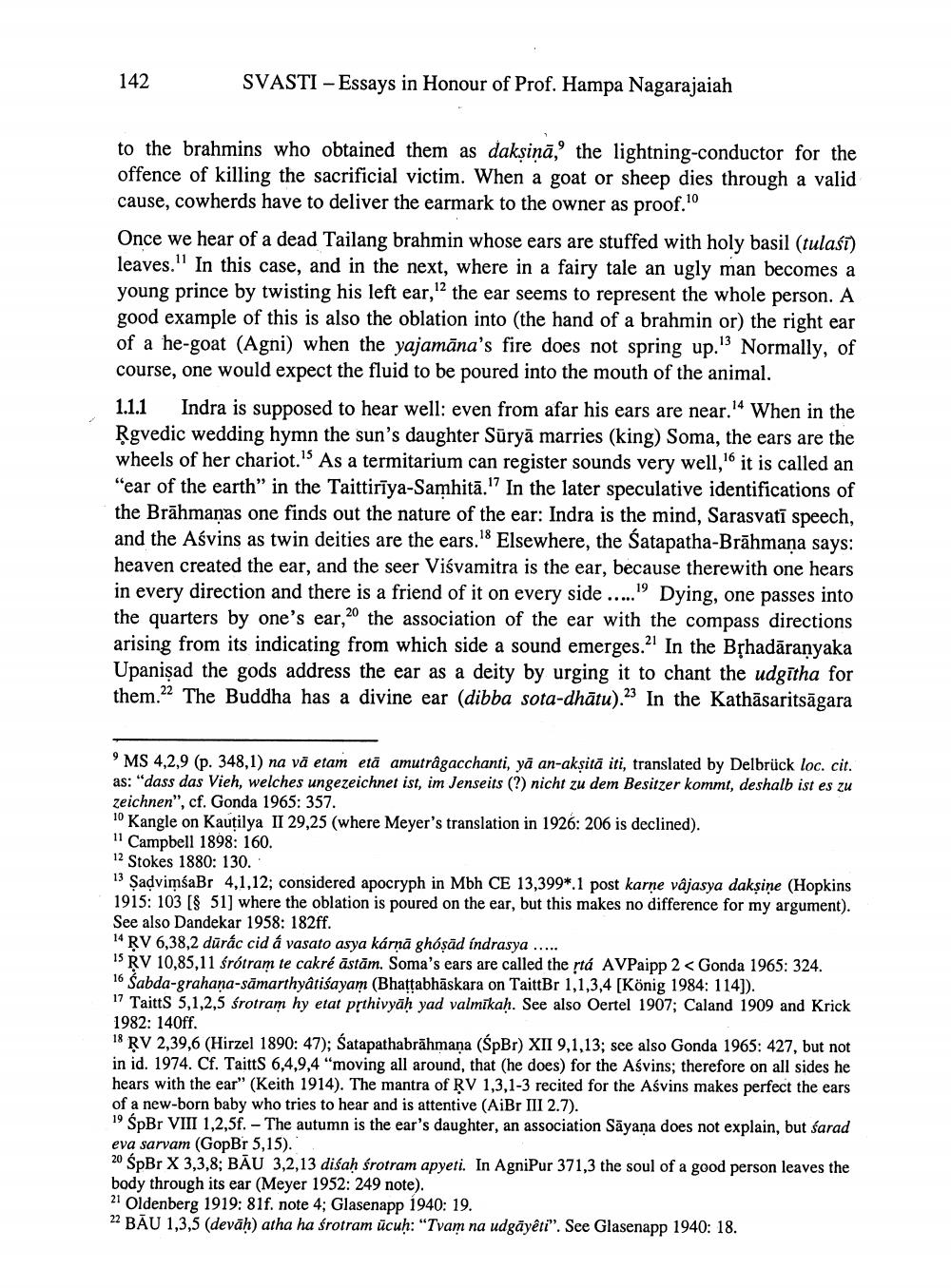________________
142
SVASTI - Essays in Honour of Prof. Hampa Nagarajaiah
to the brahmins who obtained them as daksinā, the lightning-conductor for the offence of killing the sacrificial victim. When a goat or sheep dies through a valid cause, cowherds have to deliver the earmark to the owner as proof.'' Once we hear of a dead Tailang brahmin whose ears are stuffed with holy basil (tulasi) leaves." In this case, and in the next, where in a fairy tale an ugly man becomes a young prince by twisting his left ear, the ear seems to represent the whole person. A good example of this is also the oblation into (the hand of a brahmin or) the right ear of a he-goat (Agni) when the yajamāna's fire does not spring up." Normally, of course, one would expect the fluid to be poured into the mouth of the animal. 1.1.1 Indra is supposed to hear well: even from afar his ears are near.4 When in the Rgvedic wedding hymn the sun's daughter Sūryā marries (king) Soma, the ears are the wheels of her chariot.'' As a termitarium can register sounds very well, it is called an "ear of the earth" in the Taittirīya-Samhitā.In the later speculative identifications of the Brāhmaṇas one finds out the nature of the ear: Indra is the mind, Sarasvatī speech, and the Aśvins as twin deities are the ears.18 Elsewhere, the Satapatha-Brāhmana says: heaven created the ear, and the seer Viśvamitra is the ear, because therewith one hears in every direction and there is a friend of it on every side .....'' Dying, one passes into the quarters by one's ear,20 the association of the ear with the compass directions arising from its indicating from which side a sound emerges. In the BỊhadāranyaka Upanişad the gods address the ear as a deity by urging it to chant the udgītha for them.22 The Buddha has a divine ear (dibba sota-dhātu).23 In the Kathāsaritsāgara
MS 4,2,9 (p. 348,1) na vā etam etā amutrâgacchanti, yā an-akṣitā iti, translated by Delbrück loc. cit. as: "dass das Vieh, welches ungezeichnet ist, im Jenseits (?) nicht zu dem Besitzer kommt, deshalb ist es zu zeichnen", cf. Gonda 1965: 357. 10 Kangle on Kautilya II 29,25 (where Meyer's translation in 1926: 206 is declined). 11 Campbell 1898: 160. 12 Stokes 1880: 130. 13 ŞadvimšaBr 4,1,12; considered apocryph in Mbh CE 13,399* 1 post karne vâjasya daksine (Hopkins 1915: 103 [8 51] where the oblation is poured on the ear, but this makes no difference for my argument). See also Dandekar 1958: 182ff. 14 RV 6.38.2 dūrấc cid å vasato asya kárnä ghoșäd indrasya ..... 15 RV 10,85,11 śrótram te cakré astām. Soma's ears are called the stá AVPaipp 2 < Gonda 1965: 324. 16 Sabda-grahana-sāmarthyâtiśayam (Bhattabhāskara on TaittBr 1,1,3,4 [König 1984: 114]). 17 Taitts 5,1,2,5 śrotram hy etat prthivyāh yad valmīkah. See also Oertel 1907; Caland 1909 and Krick 1982: 140ff. 18 RV 2,39,6 (Hirzel 1890: 47); Satapathabrāhmaṇa (SpBr) XII 9,1,13; see also Gonda 1965: 427, but not in id. 1974. Cf. TaittS 6,4,9,4 "moving all around, that he does) for the Aśvins; therefore on all sides he hears with the ear" (Keith 1914). The mantra of RV 1,3,1-3 recited for the Asvins makes perfect the ears of a new-born baby who tries to hear and is attentive (AiBr III 2.7). 19 ŚpBr VIII 1,2,5f. - The autumn is the ear's daughter, an association Sāyana does not explain, but sarad eva sarvam (GopBr 5,15). 20 SpBr X 3,3,8; BĀU 3,2,13 diśaḥ śrotram apyeti. In AgniPur 371,3 the soul of a good person leaves the body through its ear (Meyer 1952: 249 note). 21 Oldenberg 1919: 81f. note 4; Glasenapp 1940: 19. 22 BĀU 1,3,5 (devāḥ) atha ha śrotram ūcuh: "Tvam na udgāyêti". See Glasenapp 1940: 18.




